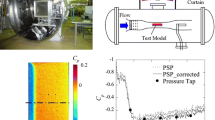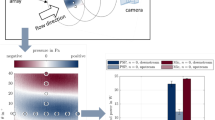Abstract
The pressure sensitive paint (PSP) intensity and lifetime system is an optical measurement technique to investigate absolute pressure fields on model surfaces for basic research in laboratories, industrial wind tunnels or high speed rotating turbo machines. Detailed qualitative and quantitative information and understanding of flow phenomena can be obtained in speed ranges from U∞=20 m/s up to Ma=5.0. A number of projects of industrial interest has been investigated in different wind tunnels covering low speed, transonic, trisonic and cryogenic facilities. The influence of the main error sources for the components of the PSP system have been checked. Comparison of experimental pressure fields obtained by means of PSP and the results of numerical calculations have been carried out. Different wind tunnel models ranging from basic configurations such as a cropped delta wing to a complex half model of a large propeller-driven transport aircraft with all flaps, rudders and shrouds, and rotating or oscillating models as well as Reynolds number effects on models have been investigated.
Similar content being viewed by others
References
Asai, K., Kanda, H., Kunimasu, T., Liu, T. and Sullivan, J. P., Boundary-Layer Transition Detection in a Cryogenic Wind Tunnel Using Luminescent Paint, Journal of Aircraft, 34-1(1997), 34–42.
Burns, S. P. and Sullivan, J. P., Pressure Sensitive Paints on Rotating Machinery, ICIASF’95 (Dayton, USA), (1995), 183-187, Engler, R. H., Further developments of pressure sensitive paint (OPMS) for non flat models in steady transonic flow and unsteady conditions, ICIASF’95 (Dayton. Ohio. USA), (1995), 163–170.
Engler, R. H., Hartmann, K. and Schulze, B., A new optical pressure measurement system (OPMS), ICIASF’91 (Rockville, Maryland, USA), (1991), 163–170.
Engler, R. H., Hartmann, K., Troyanovski, I. and Vollan, A., Description and assessment of a new optical pressure measurement system (OPMS) demonstrated in the high speed wind tunnel of DLR in Göttingen, DLR-FB 92-24 (1992), 1–66.
Engler, R. H., Merienne, M. C., Klein, Chr. and Le Sant, Y., Application of PSP in low speed flows. Aerospace Science and Technology 6 (2002), 313–322, DLR Göttingen and ONERA, Meudon.
Engler, R. H. and Klein Chr., First Results Using the New DLR PSP system — intensity and lifetime measurements, Conference “Wind Tunnels and Wind Tunnel Test Techniques” (Cambridge, UK), (1997), 43.1–43.9.
Fey, U., Engler, R. H., Egami, Y., Iijima, Y., Asai, K., Jansen, U. and Quest, J., Transition detection by temperature sensitive paint at cryogenic temperatures in the European Transonic Wind Tunnel (ETW), ICIASF’03 (Göttingen, Germany),(2003), 77–88.
Gadella, T., Jovin, T. and Cegg, R., Fluorescence lifetime imaging microscopy (FLIM): Spatial resolution of microstructures on the nanosecond time scale, Journal Biophysical Chemistry, 48 (1993), 221–239.
Iijima, Y., Egami, Y., Nishizawa, A., Asai, K. and Fey, U., Engler R. H., Optimization of Temperature-Sensitive Paint Formulation for Large-Scale Cryogenic Wind Tunnels, 20th ICIASF’03 (Göttingen, Germany), (2003), 70–76, DLR Göttingen and NAL Japan.
Klein, Chr., Einsatz einer druckempfindlichen Beschichtung (PSP) zur Bestimmung des momentanen Druckfeldes von Modellen im Windkanal, DLR-Forschungsbericht, 97–55 (1997), Dissertation University Göttingen, Germany, ISSN 1434–8454.
Klein, Chr. and Engler, R. H., Visualization of Aerodynamic Effects on a Double-Delta wing aircraft model using Pressure Sensitive Paint (PSP) Technique, Journal of Visualization, 2-1 (1999), 9–16.
Ruyten, W. and Fisher, C., On the Effects of Reflected Light in Luminescent Paint Measurements, 38th Aerospace Sciences Meeting and Exhibit, (2002), AIAA-2000-0833.
Sellers, M. E., Application of Pressure Sensitive Paint for Determining Aerodynamic Loads on a Scale of the F-16C, 21st AIAA Conference, (2000), AIAA 2000-2528.
Author information
Authors and Affiliations
Corresponding author
Additional information
Rolf H. Engler: He received his Dipl. Ing. degree at the Ing.-Academy of Wolfenbüttel in the field of air conditioning in 1969. After three years in industry, he started a study at the University of Göttingen and received his Dipl. Physiker degree in 1979 for Vortex investigation using Ultrasonic pulses. In 1986 he received the Dr. rer. nat. degree for experimental investigations of vortex breakdown using a newly developed non intrusive technique — t he Ultrasonic-Laser-Method. Since 1991 he works on pressure-sensitive-paint techniques (PSP) in different wind tunnels of DLR and Europe and is leader of the PSP team at DLR.
Uwe Fey: He studied physics at the University of Göttingen and received his Diploma in 1994 for an experimental investigation of the laminar-turbulent transition of the cylinder wake. He continued his work at the Max-Planck Institut for Fluid Dynamics in Göttingen and in 1997 he received his Ph.D. Thereafter he joined the Research Center Rossendorf (FZR) near Dresden and worked in the field of magneto-hydrodynamics and was involved in experiments on boundary layer control by means of electromagnetic forces. Since 2002 he is a member of the PSP team at DLR Göttingen and responsible for cryogenic PSP and TSP in co-operation with ETW.
Ulrich Henne: He studied physics at the University Hannover. In his diploma work he investigated inelastic collisions between He+ ions and Ne atoms at low energies which he finished in 1989. For his Ph.D. thesis he joined the Max-Planck Institute for Fluid Mechanics in Göttingen where he worked on ionization and electron capture of large He clusters. After receiving his doctoral degree in 1996 from the University Göttingen he worked at the PTB in Braunschweig on determination of cross sections of low energy electron ionization. Since 2001 he works as a researcher in the field of PSP development at DLR in Göttingen.
Christian Klein: He studied physics at the University of Göttingen and joined for his diploma work the Max-Planck Institute for Fluid Mechanics in Göttingen. The diploma work was an experimental investigation of turbulent channel flow using LDV. He received his diploma degree in 1994. For his following Ph.D. thesis, he investigated the application of Pressure Sensitive Paint (PSP) for transonic flows at the German Aerospace Center in Göttingen. He received his doctoral degree in 1997 from the University of Göttingen. Currently, he works as a researcher in the field of PSP applications for low-speed and unsteady flows.
Werner E. Sachs: His first study of mechanical engineering with priority of aerodynamics at the University of Paderborn he finished in 1975. The second study of Mathematics at the Georg-August-University of Göttingen was finished at 1983. Since 1983 he is scientist at DLR working in different sections: basic research in commission for (ESA) in the field of structure dynamics of satellites. Wind tunnel flutter investigations of turbine and compressor cascades, hereafter he finished with the degree of Dr.-Ing. at the RWTH Aachen. From 1990 to 2000 he was head of the electronic data processing and measurement technique group at the main division of wind tunnels at DLR Göttingen. Since 2000 he mainly develops software (ToPas) in the DLR PSP team.
Rights and permissions
About this article
Cite this article
Engler, R.H., Fey, U., Henne, U. et al. Quantitative wind tunnel studies using pressure- and temperature sensitive paints. J Vis 8, 277–284 (2005). https://doi.org/10.1007/BF03181506
Received:
Revised:
Issue Date:
DOI: https://doi.org/10.1007/BF03181506




